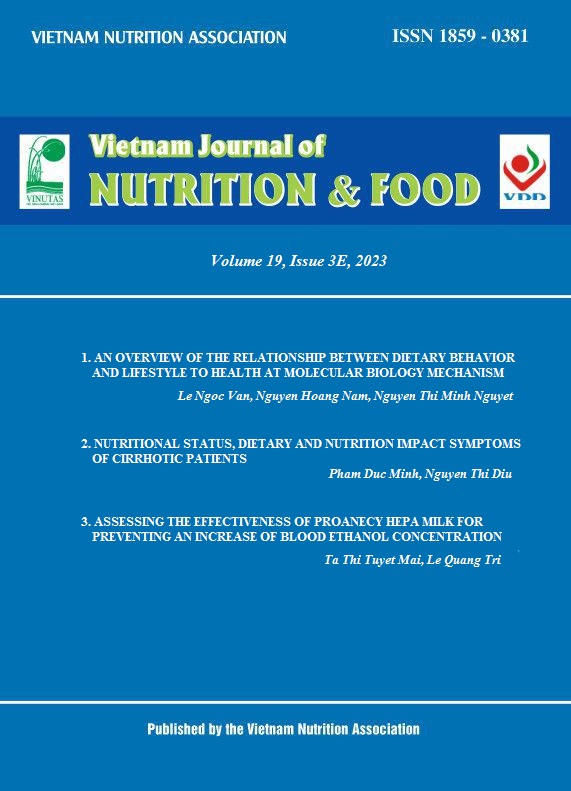ĐÁNH GIÁ HIỆU QUẢ CỦA SỮA PROANECY HEPA MILK TRONG NGĂN NGỪA TĂNG NỒNG ĐỘ CỒN TRONG MÁU
Nội dung chính của bài viết
Tóm tắt
Mục tiêu: Đánh giá hiệu quả hạn chế tăng nồng độ ethanol trong máu khi uống 6ml/kg sữa Proanecy Hepa 30 phút trước uống 0,5g ethanol/kg cân nặng.
Phương pháp: Một thử nghiệm lâm sàng tự chứng với 6 thử nghiệm chéo về dược động học của ethanol đã được thực hiện. Mười sinh viên tham gia 6 thử nghiệm, ở mỗi thử nghiệm tất cả sinh viên đều nhịn ăn hôm trước và sáng hôm sau trước khi uống rượu mỗi nhóm uống các đồ uống khác nhau gồm nước tinh khiết, thuốc giải rượu, sữa Proanecy Hepa, sữa Proanecy Hepa không Silymarin, Silymarin, và sữa hỗ trợ gan. Nồng độ ethanol trong máu được đo bằng phương pháp sắc ký khí tại 5 thời điểm: trước khi uống rượu (t0) và sau khi uống rượu 60 phút (t1), 120 phút (t2), 180 phút (t3) và 240 phút (t4).
Kết quả: Nhóm sử dụng sữa Proanecy Hepa cho thấy mức tăng nồng độ ethanol trong máu thấp hơn đáng kể, được biểu thị bằng diện tích gia tăng dưới đường cong (iAUC) (trung vị: 170,9; khoảng tứ phân vị: 50,5-470,8), so với các nhóm khác (p <0,001). Trung vị và khoảng tứ phân vị của iAUC cho các nhóm còn lại như sau: nước tinh khiết (2885,1; 2405,7-3005,3), thuốc giải rượu (2973,9; 2744,2-3369,5), sữa Proanecy Hepa không có Silymarin (2295,9; 1222,5-2569,4), Silymarin (3411,8; 3006,2-3922) và sữa hỗ trợ gan (2739,4; 2431,8-3149,4). Hơn nữa, những người uống 6 ml/kg sữa Proanecy Hepa trước khi uống rượu đã duy trì nồng độ ethanol trong máu thấp dưới ngưỡng 10 mg/dl tại tất cả các thời điểm đo (60, 120, 180 và 240 phút). Ngược lại, những người trong các nhóm còn lại có nồng độ ethanol trong máu vượt quá ngưỡng 10 mg/dl tại các thời điểm 60, 120 và 180 phút, sau đó trở về dưới ngưỡng 10 mg/dl từ phút thứ 240.
Kết luận: Nghiên cứu cho thấy uống 6 ml/kg sữa Proanecy Hepa 30 phút trước khi uống 0,5g cồn/kg cân nặng có thể giúp ngăn nồng độ cồn trong máu vượt ngưỡng 10 mg/dl.
Từ khóa
Sữa Proanecy Hepa, giải độc rượu, nồng độ cồn trong máu, sữa bổ gan, Silymarin
Chi tiết bài viết
Tài liệu tham khảo
2. WHO Global status report on Alcohol and Health. WHO 2014;1–20: 288 -290.
3. Vissers L, Houwing S, Wegman F. Alcohol-related road casualties in official crash statistics Paris, France: OECD International Transport Forum. 2017 https://www.itf oecd.org/sites/default/files/docs/alcoholrelated-road-casualties-official-crash-statistics.pdf.
4. Vietnamese Government. 100/2019/NĐ-CP. Administrative Penalties for Road Traffic Offences and Rail Transport Offences, 12/30/2019.
5. Jones AW, Jönsson KA, Kechagias S. Effect of high-fat, high-protein, and high-carbohydrate meals on the pharmacokinetics of a small dose of ethanol. Br J Clin Pharmacol. 1997;44(6):521-526.doi:10.1046/j.1365-2125.1997.t01-1-00620.x.
6. Laura T, Giovanni C, Chiara R, et al. A specific amino acid formula prevents alcoholic liver disease in rodents. American Journal of Physiology-Gastrointestinal and Liver Physiology. 2018;314(5):G566-G582.
7. Mitchell MC Jr, Teigen EL, Ramchandani VA. Absorption and peak blood alcohol concentration after drinking beer, wine, or spirits. Alcohol Clin Exp Res. 2014;38(5):1200-1204. doi:10.1111/acer.12355
8. Jung YC, & Namkoong K. Alcohol: intoxication and poisoning - diagnosis, and treatment. Handbook of clinical neurology. 2014; 125:115–121. https://doi.org/10.1016/B978-0-444-62619-6.00007-0.
9. Aarons L and Ogungbenro K. Optimal Design of Pharmacokinetic Studies. Basic & Clinical Pharmacology & Toxicology. 2010;106:250-255.https://doi.org/10.1111/j.1742-7843.2009.00533.x
10. International Standards Organization. ISO 26642: Food products - Determination of the glycaemic index (GI) and recommendation for food classification. Geneva (Switzerland): ISO; 2010 Available from:https://www.iso.org/standard/43633.html.
11. Cederbaum AI. Alcohol metabolism. Clinics in liver disease. 2012;16(4):667. https://doi.org/10.1016/j.cld.2012.08.002.
12. Levitt MD, Furne J, DeMaster E First pass metabolism of ethanol is in rat gastric mucosa. Alcoholism: Clin Exp Res. 1997; 21:293–297.
13. Lee SL, Chau GY, Yao CT, et al. Functional assessment of human alcohol dehydrogenase family in ethanol metabolism: Significance of first-pass metabolism. Alcoholism: Clin Exp Res. 2006; 30:1132–1142.
14. Wilkinson PK, Sedman AJ, Sakmar E, Kay DR, Wagner JG. Pharmacokinetics of ethanol after oral administration in the fasting state. J Pharmacokinet Biopharm. 1977;5(3):207-224. doi: 10.1007/BF01065396.
15. Brandon-Warner E, Sugg JA, Schrum LW, McKillop IH. Silibinin inhibits ethanol metabolism and ethanol-dependent cell proliferation in an in vitro model of hepatocellular carcinoma. Cancer Lett. 2010;291(1):120-129. doi:10.1016/j.canlet.2009.10.004
16. Jing L, Xiaoyu Z, Chong Z, et al. Co-expression of alcohol dehydrogenase and aldehyde dehydrogenase in Bacillus subtilis for alcohol detoxification. Food and Chemical Toxicology. 2020;135, ISSN 0278-6915, https://doi.org/10.1016/j.fct.2019.110890 .
17. Jung SJ, Hwang JH, Park EO, et al. Regulation of Alcohol and Acetaldehyde Metabolism by a Mixture of Lactobacillus and Bifidobacterium Species in Human. Nutrients. 2021; 13(6): 1875. https://doi.org/10.3390/nu13061875 .
18. Wissel PS. Dietary influences on ethanol metabolism. Drug-Nutrient Interact. 1987; 5:161–168.


